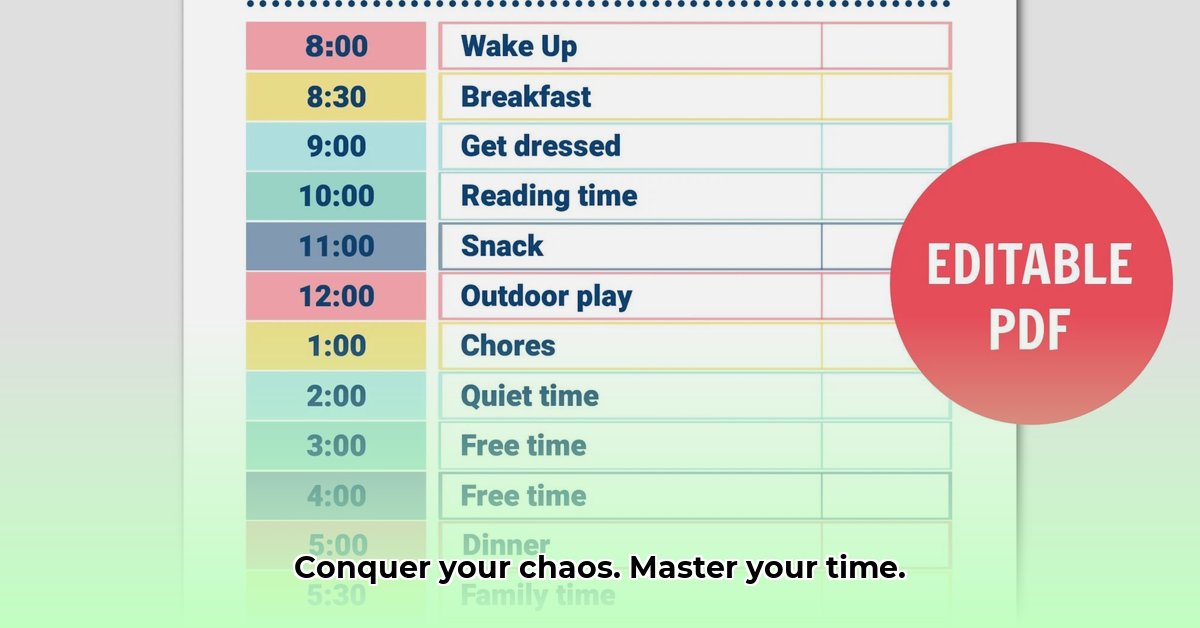Drowning in tasks and deadlines? Feeling like there just aren’t enough hours in the day? You’re not alone! This guide is your lifeline to taking control of your time. We’ll walk you through simple yet powerful techniques – like the Pomodoro Technique and time blocking – to boost your productivity. We’ll also show you how to prioritize what really matters, avoid common time-wasting traps, and create a personalized system that actually works for you. Get ready to reclaim your time and achieve more than you ever thought possible!
For more advanced strategies, check out these time management tips.
Unlock Productivity: Understanding Key Schedule and Time Management Principles
Let’s be honest, feeling overwhelmed is part of the human experience. We all juggle many things! But smart time management isn’t about cramming more into your day; it’s about making the most of what you have. Think of your day like a delicious meal – you wouldn’t just throw everything in a pot randomly, would you? You’d carefully plan and prepare each dish (task) to create a satisfying experience. Right now, what’s your “meal” looking like? A bit chaotic? Let’s get it organized!
Effective time management is a crucial skill, involving planning and prioritizing daily tasks to use time effectively, complete important projects, and meet deadlines. It also requires being conscious and selective about how time is spent, balancing personal, professional, and educational obligations. The benefits are substantial: increased productivity, a better work-life-education balance, improved focus, higher quality of work, and reduced anxiety and stress.
Prioritize Effectively: Strategies for Task Management and Goal Achievement
We simply can’t do everything. This is where prioritization becomes your superpower. The Eisenhower Matrix is a tried-and-true method:
| Quadrant | Description | Example | What to Do |
|---|---|---|---|
| I | Urgent & Important | A looming project deadline | Tackle it immediately! |
| II | Important, Not Urgent | Planning a big trip | Schedule specific time blocks for planning. |
| III | Urgent, Not Important | Unnecessary meetings | Delegate or politely decline. |
| IV | Neither Urgent nor Important | Mindless scrolling | Delete those apps from your phone! Eliminate it completely. |
Another popular trick is the “Eat the Frog” method – tackle your biggest, most challenging task first thing. Think of it as getting the unpleasant stuff over with early; the rest of the day will feel like a breeze in comparison. As Brian Tracy, author of “Eat That Frog!: 21 Great Ways to Stop Procrastinating and Get More Done in Less Time,” suggests, completing your most challenging task first thing in the morning can give you a sense of accomplishment, provide motivation, and set a productive tone for the rest of your day. Now, which method sounds more appealing to you?
Consider your personality and work style when selecting a method. Experiment and discover what works best to help you achieve your goals.
Time Management Techniques: Finding the Right Schedule and Plan for You
There are several proven techniques to help you master your time. Let’s explore a few:
-
The Pomodoro Technique: This involves working in focused bursts – typically 25 minutes – followed by a short break. This structured approach can dramatically boost your concentration. Imagine powering through tasks with laser focus! It’s great for deep, concentrated work. Francesco Cirillo invented this time management method in the 1980s and named it “Pomodoro” after the tomato-shaped kitchen timer he used to track his work.
-
Time Blocking: This method is all about scheduling specific time slots for different tasks in your calendar. Think of it as creating a visual roadmap for your day; it gives you a clear picture of your upcoming obligations and prevents tasks from bleeding into each other. It’s like reserving a table at your favorite restaurant—you know exactly when you’ll be there. To get started, divide each 24-hour day into small blocks of time. Estimate how long it will take to complete daily tasks and assign them to specific time blocks in a planner or calendar app. Schedule breaks between the start and end of each task.
-
The Kanban Method: This visual system uses cards or sticky notes to track the progress of your tasks. It’s a fantastic approach for managing multiple projects simultaneously, giving you a bird’s-eye view of everything. You’ll literally see the workflow. The Kanban technique was implemented in the 1960s by Taiichi Ohno to improve productivity and efficacy in the manufacturing process at Toyota Automotive. To get started, you’ll need project management software, a whiteboard, or sticky notes. Then divide your project into four phases and create columns for each: Backlog, To Do, In Progress, and Done.
Remember, these methods aren’t competing; they complement each other. Experiment with different combinations to find a system that suits you best. It’s all about personalizing your approach.
Conquering Challenges: Dealing with Interruptions and Time Wasters
Even the best-laid plans can encounter unexpected roadblocks. Let’s discuss some common hurdles:
- Distractions: We live in a hyper-connected world, but constant notifications and interruptions are productivity killers. Minimize those distractions! Designate a specific workspace free of interruptions, and consider using website blockers or apps that limit notifications during focused work periods. Focus is king, remember?
- Procrastination: We all do it sometimes. The key is breaking down large, overwhelming tasks into smaller, more manageable chunks. This makes the overall project seem less daunting and encourages progress. Remember, small steps lead to big achievements.
- Perfectionism: This can be a major time-waster. Strive for “good enough” rather than flawless perfection. Done is better than perfect, especially when it comes to meeting deadlines.
Remember, the journey is more important than the destination. Focus on the progress, not the pursuit of perfection.
Building Strong Habits: Making Time Management a Consistent Practice
Like any skill, effective time management requires consistent effort and refinement.
- Start Small: Don’t try to revamp your entire system overnight. Begin with one technique, master it, and then gradually add others. Remember, slow and steady wins the race.
- Regular Review: Once a week, take a moment to assess your progress. What’s working well? What needs fine-tuning? Adaptability is key.
- Be Kind to Yourself: There will be days when things don’t go as planned, and that’s okay! Everyone has setbacks. Learn from your mistakes, adjust your approach, and keep moving forward.
Consistency is the key to long-term success and sustainable habits.
Utilizing Technology: Best Schedule and Time Management Apps and Tools
Plenty of tools can assist you in your time management journey. Here are a few examples:
- Calendar Apps: Google Calendar, Outlook Calendar – these are your digital planners, helping you schedule events and tasks.
- Task Management Apps: Todoist, Asana, Trello – these apps help organize tasks, prioritize them, and track your progress.
- Focus Apps: Freedom, Forest – these apps can help you minimize distractions by blocking websites or providing gamified rewards for focused periods.
Choose tools that complement your style, and don’t feel pressured to use every single app available.
Personalize Your Approach: Finding a System That Works Best
The most effective time management system is one that you actually use and enjoy. It’s a deeply personal journey, so experiment, adapt, and refine your methods until you land on the perfect combination. Your unique approach is the key to your success. Remember, it’s a marathon, not a sprint! Celebrate the small victories along the way.
Synergistic Strategies: Optimize Pomodoro and Time Blocking Together
Feeling overwhelmed by your to-do list? Do you struggle to stay focused and consistently meet deadlines? Learning how to combine Pomodoro and time blocking for maximum productivity can transform your approach to time management. This powerful combination allows you to structure your day while maintaining focused work sprints. Let’s dive in.
Deep Dive: Understanding How Time Blocking Works
Time blocking is a simple yet effective strategy. You allocate specific time slots for particular tasks. It’s like creating a detailed roadmap for your day. Think of it as reserving appointments with yourself—appointments to work on specific projects. This provides a clear framework for your workday.
Pomodoro Deep Dive: Improving Focus and Task Management
The Pomodoro Technique involves working in focused bursts, typically 25 minutes long, followed by a short break (usually 5 minutes). These focused sessions are intense periods of concentration. After four “Pomodoros,” take a longer break (15-20 minutes). This structured approach keeps you engaged and prevents burnout.
Combining the Two: A Powerful Hybrid Strategy
The real magic happens when you combine these. Time blocking provides the overall structure; Pomodoros provide focused work within those blocks. For example, you might block out two hours for writing a report. Within that block, you’d work in 25-minute Pomodoro sessions. This method ensures focused attention.
Actionable Advice: Implementing the Combined Techniques
- Prioritize Tasks: Identify your most important tasks for the day. Use methods like the Eisenhower Matrix (urgent/important) to determine priorities.
- Block Your Time: Allocate specific time blocks for each prioritized task, considering realistic time estimates. Be honest!
- Implement Pomodoros: Within each time block, work in 25-minute Pomodoro sessions with short breaks.
- Track Your Progress: Use a timer or app to track your Pomodoro sessions. Regularly review your progress.
- Adjust and Adapt: Time blocking and Pomodoro are frameworks; adjust them to suit your individual needs and preferences. Experiment to find what works best.
Assessing Effectiveness: Advantages and Disadvantages
| Feature | Pros | Cons |
|---|---|---|
| Focus & Productivity | Increased concentration, minimized distractions, enhanced task completion. | Requires discipline and self-awareness to stick to the schedule and Pomodoro intervals. |
| Planning & Organization | Improved organization, better time management, reduced feeling of overwhelm. | Can be inflexible if unexpected tasks or interruptions arise. |
| Work-Life Balance | Encourages regular breaks, preventing burnout; establishes clear boundaries. | Requires upfront planning and commitment to be effective. |
Essential Insights: Key Takeaways
- Time blocking gives you a daily outline.
- Pomodoros enhance focus during those blocks.
- Regularly review and adjust your system.
- Prioritize tasks using a system that works for you.
- Consistency is key to seeing results.
Combining Time Blocking and the Pomodoro Technique: A Productivity Powerhouse
Enhancing Focus: Effective Time Blocking Strategies Detailed Guide
Key Takeaways:
- Time Blocking is about strategic planning and intentional allocation of your time
- Successful implementation requires careful planning, adaptation, and consistency
- Integrating time blocking with other techniques (Pomodoro, Eisenhower Matrix) enhances impact
- Accurate task duration estimation is crucial for effective scheduling
- Choosing the right digital tools depends on individual preferences and workflow and is essential to keep you on track
Time Blocking Defined: Strategic Planning for Improved Output
Time blocking isn’t about rigid schedules; it’s about intentional allocation of your time. Think of it as creating a roadmap for your day, guiding you toward your goals. You’ll assign specific time slots for specific tasks. This simple act reduces decision fatigue – that mental drain from constantly choosing what to do next. Done right, it frees up mental energy for actual work!
Implementation Guide: How to Create Effective Time Blocks
- Identify Your Peak Productivity Times: When are you most alert and focused? Schedule your most demanding tasks for these periods.
- List Your Tasks: Brain dump everything you need to accomplish. Be detailed!
- Estimate Time: Honestly assess how long each task will take. Over- or underestimation derails the whole system. Start with rough estimates, then refine as you learn.
- Prioritize Ruthlessly: Use the Eisenhower Matrix (Urgent/Important) or another method to focus on high-value activities.
- Allocate Time Slots: Block out time for each task in your calendar. Be realistic; don’t overschedule. Leave buffer time!
- Batch Similar Tasks: Group similar activities together (e.g., answering emails, making phone calls). This minimizes mental shifts.
- Review and Adjust: At the end of each day or week, reflect on your schedule’s effectiveness. What worked well? What needs tweaking?
Efficient Choices: Techniques for Prioritization & Time Management
The Eisenhower Matrix helps categorize tasks by urgency and importance. “Eat the Frog” – tackle your most challenging task first – boosts early momentum. The “Pickle Jar” analogy (big rocks, pebbles, sand) visually demonstrates prioritizing essential goals. Select the technique that best suits your personality and task complexity.
Common Pitfalls: How to Overcome Obstacles and Time Wasters
Distractions are inevitable. Minimize interruptions by turning off notifications, designating focused workspaces, and communicating your availability to colleagues. Procrastination is a habit, not a personality trait. Break down large tasks into smaller, manageable steps. Perfectionism can be paralyzing; aim for progress, not perfection. Schedule regular breaks to maintain focus and avoid burnout.
Integration Strategy: Synergizing Techniques for Better Results
The Pomodoro Technique (25 minutes of focused work followed by a 5-minute break) can be incorporated within your time blocks. Combining time blocking with task batching creates a powerful synergy, improving both efficiency and focus. Experiment to discover what works for you.
Helpful Resources: Optimizing Your Time-Blocking Journey
Many tools can support your time-blocking journey. A simple paper planner works wonders; so do sophisticated apps like Google Calendar or Todoist. The best tool is the one you consistently use.
Kanban For Projects: Managing Time Allocation for Complex Projects
Key Takeaways:
- Effective project scheduling is crucial for success, impacting resource allocation, deadlines, and overall outcomes
- The choice of scheduling technique depends heavily on project complexity, team structure, and available resources
- Visualizations like Kanban boards significantly improve communication and progress tracking
- Optimizing Time Allocation for Complex Projects using Kanban offers flexibility and iterative development
- Balancing speed and risk/cost requires careful consideration in any project scheduling approach
Introduction to Kanban: Visualize and Optimize Workflow
Kanban, a visual system for managing workflow, is particularly effective for optimizing time allocation for complex projects. Think of it as a dynamic to-do list, constantly adapting to changing priorities. Instead of rigid phases, Kanban uses a continuous flow. Tasks move across columns representing stages of completion (e.g., “To Do,” “In Progress,” “Done”). This visual representation provides constant transparency, allowing everyone on the team to grasp the project’s status quickly.
What makes Kanban so powerful? Its adaptability. Unlike rigid plans, Kanban embraces changes. This is crucial for complex projects, where unexpected roadblocks are almost guaranteed.
Implementing the Kanban: A Step-by-Step Guide
- Visualize your workflow: Create a Kanban board, either physically or using software. Clearly define stages of your project’s workflow.
- Limit Work in Progress (WIP): Avoid starting too many tasks at once. Focus on completing one before moving on. This prevents overwhelm and improves focus.
- Manage your flow: Regularly review your Kanban board. Identify bottlenecks. Adjust workflow to keep everything moving smoothly.
- Prioritize tasks: Use a prioritization method (like the Eisenhower Matrix) to ensure you’re tackling the most important tasks first. Remember that context matters. What’s urgent one day might not be so crucial another day.
- Embrace continuous improvement: Regularly assess your system. What works? What doesn’t? Refine your workflow based on your experiences.
Kanban Pros & Cons: Is This the Right Solution for You?
| Feature | Strengths | Weaknesses |
|---|---|---|
| Flexibility | Adapts easily to changing priorities and unexpected issues. | Can lack structure for entirely new projects. |
| Visual Representation | Provides clear overview of workflow and progress. | Requires discipline to maintain and update accurately. |
| Continuous Improvement | Encourages regular review and refinement of processes. | Not ideal for projects with stringent sequential dependencies. |
| Collaboration | Facilitates teamwork and communication. | Can become overly complex if not managed carefully, especially in large teams. |
Leveraging Kanban: Working in Harmony with Other Techniques
Kanban’s not a standalone solution; it’s a powerful tool when combined with other techniques. For instance, using the Pomodoro Technique within each Kanban task can boost focus. Time blocking ensures dedicated time for critical tasks. The Eisenhower Matrix aids in prioritizing what goes onto your Kanban board in the first place. Finding the right combination for your workflow is key.
Remember, optimizing time allocation for complex projects using Kanban requires a bit of experimentation. What works for one team won’t necessarily work for another. Be open to adapting your approach as you go.
Kanban Time Management Techniques to be More Productive
- Unlock Work-Life Harmony:Your Guide to Integration - November 27, 2025
- Find Your Work-Life Balance Quotes: Achieve Harmony Now - November 25, 2025
- Unlock Physician Assistant Work Life Balance: Your Guide to Fulfillment - November 23, 2025
















